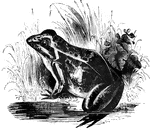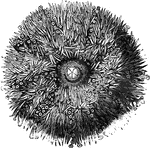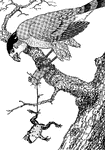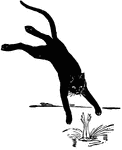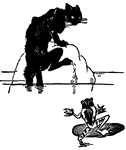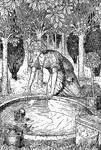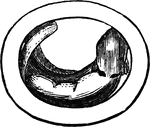
Embryo
"Figure 1 represents the embryo as it appears several days after the egg is deposited." — Goodrich.…

Form of the embryo
"Figure 2 gives an outline of its form; the arrows at the side of the head show the currents of water…
Newly hatched tadpole
"Figure 5 shows the form of the tadpole when first hatched, which usually takes place about four weeks…

Frog with tail
Nearing the end of its development, a gradually shrinking tail is all that remains of the tadpole.
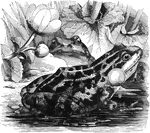
Edible frog
"It is rather larger than the common frog, and its nocturnal croakings are so loud and disagreeable,…
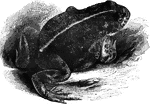
Natter-jack toad
"Resembles the common toad of Europe in appearance: there are also other foreign species, among which…

Surinam toad
"At the breeding season the back of the female exhbits a number of small pits; into these pits the male…
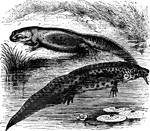
Smooth newt
"It is three and a half inches long, the skin smooth as a frog's; it lives in ponds and ditches, and…

Sticklebacks and Nest
"A few fish, however, form a sort of nest for the protection of their eggs and young; and in some instances,…

Pipefish
"Have a long, eel-like body, with the jaws united forming a tube nearly cylindrical. The eggs of the…

Angler
"The fishing frog is three to five feet long. It has an enormous mouth, armed with numerous pointed…
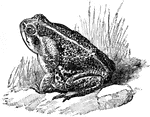
Bufo Toad
"Agua-Toad (Bufo marinus), a very large and common South American toad, with enormous parotid glands."-Whitney,…

Nurse Frog
"A genus of anurous amphibians, or tailless batrachians, of the family Discoglossidæ, sometimes…

Sacred Beetle
"Many of the dung beetles, among which the Sacred Beetle of the Egyptians, Scarabus Aegyptiorum,…

Angler
"The fish Lophius piscatorius, the typical representative of the family Lophiidæ."-Whitney, 1902
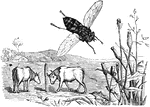
Ox Fly
"The Ox-fly, Oestrus bovis, is three-forths of an inch long, and lays its eggs in the skin of young…
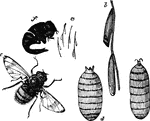
Breeze Fly
"a, eggs of the Breeze-fly; b, the same magnified; c, larva, or bot; d, chrysalis; e, perfect insect;…
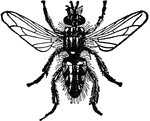
Blow Fly
"Blow Fly is the name popularly given to such two winged flies as deposit eggs in the flesh of animals,…

Colorado Beetle Eggs
"The Colorado Beetle is a beetle first described by Thomas Say, in 1824, from specimens found by him…

Asparagus Beetle
"Asparagus-Beetle (Crioceris asparagi). a,b,d and e, beetle eggs, and larvæ, natural size; c and…
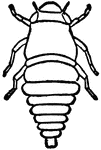
Larval Frog Hopper
"Frog Hoppers are ranked under the homopterous sub-order of insects. The name of frog hopper refers…
Frog Hopper on Leaf
"Frog Hoppers are ranked under the homopterous sub-order of insects. The name of frog hopper refers…

Adult Frog Hopper
"Frog Hoppers are ranked under the homopterous sub-order of insects. The name of frog hopper refers…

Galvanic Battery
"Galvanism is the branch of electric science to which an experiment by Galvani gave birth. His wife,…

Skeleton of Turtle
"Turtle is, in zoology, the popular name for any species of the Cheloniidæ. They may be distinguished…

Daphnia Pulex Water Flea
"Water Flea is a popular name for minute aquatic Crustaceans such as daphnia, cypris, and cyclops. The…
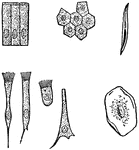
Various kinds of epithelial cells
"A, columnar cells of intestine; B, polyhedral cells of the conjuctiva; C, ciliated conical cells of…

Iguana
"Iguana is a genus of saurian reptiles, natives of Brazil, Cayenne, the Bahamas, and neighboring localities…

Circulation of blood
"Showing how the circulation of blood in the web of a frog's foot looks as seen under the microscope."…

Lizard
"Lizard is the popular name of numerous reptiles having usually two pairs of limbs and an elongated…

Osprey
"The Osprey, the fish hawk, bald buzzard, or fishing eagle. A bird of prey, of almost world wide distribution…

Compound microscope
"A Compound Microscope. The appearance of the various structures and tissues of the human body as revealed…
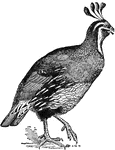
Lophortyx Californicus Quail
"The Quail is a small game bird; the Virginia species is common in North America, and so far south as…
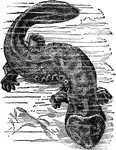
Salamander
"Salamander is a genus of reptiles closely allied to the frog, from which it differs in having an elongated…

Sand Lizard
"The Sand Lizard is a common European lizard, about seven inches long, of which the tail is four. Usual…

Seventeen Year Locust
The Seventeen Year Locust (Cicada septendecim) spends seventeen years underground feeding on the roots…

Tadpole
"The Tadpole is the larva of the anurous amphibia, sometimes so far extended as to include larvaæ…

Tadpole
"The Tadpole is the larva of the anurous amphibia, sometimes so far extended as to include larvaæ…
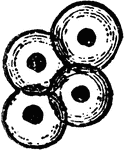
Frog Eggs
"The Tadpole is the larva of the anurous amphibia, sometimes so far extended as to include larvaæ…

Frog Egg
"The Tadpole is the larva of the anurous amphibia, sometimes so far extended as to include larvaæ…
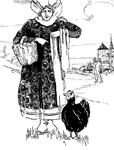
Black Hen
Higgledy Piggledy, my black hen; She lays eggs for gentlmen; Sometimes nine, and sometimes ten. Higgledy…
